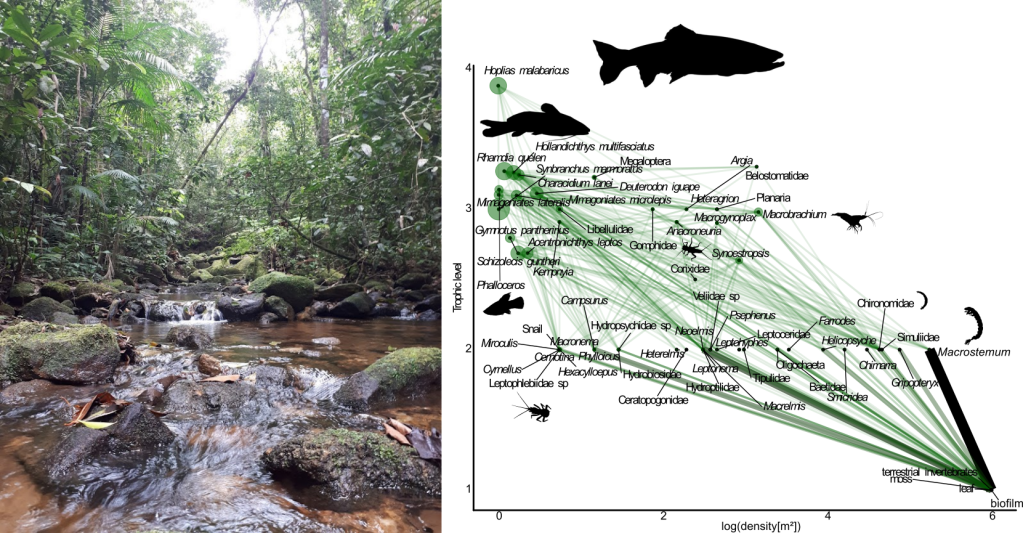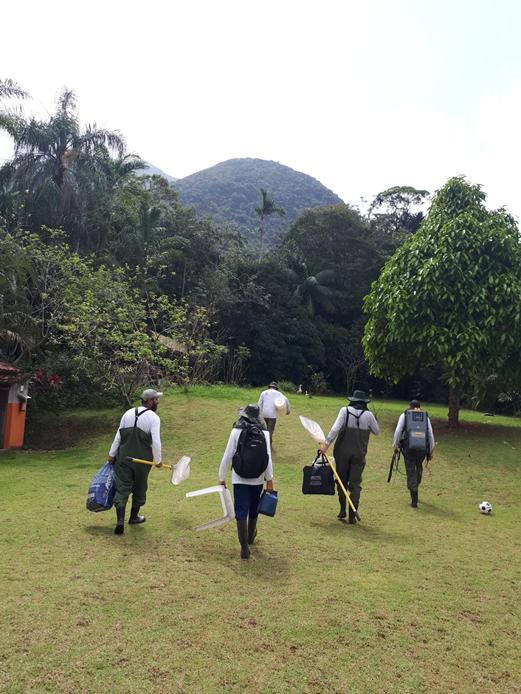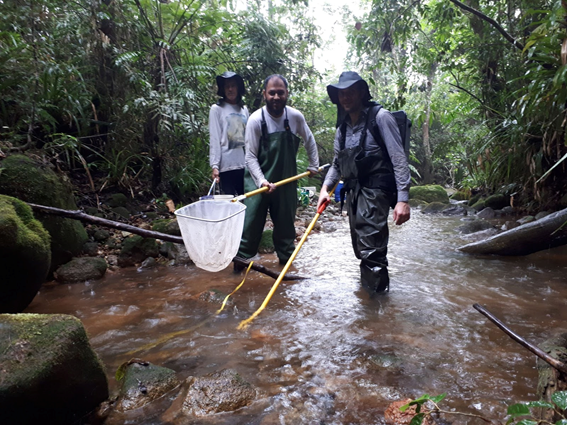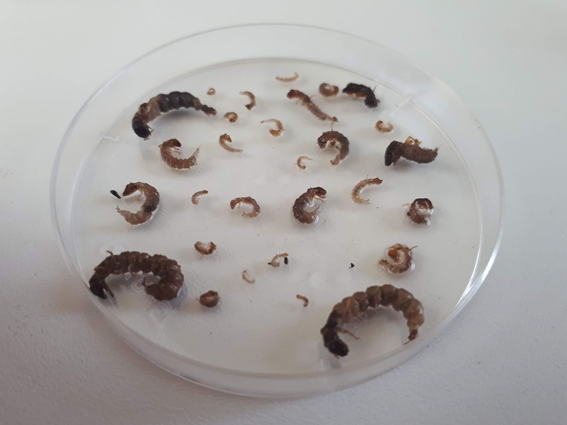This blog post is provided by Victor Saito and tells the #StoryBehindthePaper for the paper “Untangling the complex food webs of tropical rainforest streams”, which was recently published in the Journal of Animal Ecology. In their study, Saito and colleagues characterise the food webs of rocky streams in the Atlantic Rainforest, finding the systems to be highly complex and diverse, which results in high stability.

The Atlantic Rainforest is arguably the most threatened rainforest in the world. Comprising a large diversity of plants and animals both on land and in freshwaters, the forest is a biological hotspot also harboring a number of endemic and cryptic species. Located in the region where 70% of the Brazilian population lives and where 80% of the gross domestic product is found, this area has a long history of human impact, from extensive cattle grazing to mechanized sugar cane plantations. Iconically, the tree that gives the name of the country – Paubrasilia echinata – was once common in this forest, but is now considered ‘endangered’ by the IUCN.
Within the numerous valleys and creeks of the Atlantic Mountain range we can find rocky streams that feed important rivers such as the Tiete and the Parana. These small streams are important because they support a disproportionately high diversity of species considering the area they occupy, providing numerous ecosystem services to society such as clean water and recreational fishing. In a small watershed southeast of São Paulo we characterized five individual stream food webs that sum up to form a regional meta food web. By applying a detailed protocol, collecting basal resources, invertebrates and fish we were able to integrate the different components (stable isotopes, gut content analyses and a literature review) using a recently developed Bayesian framework to define the most probable food webs described for these systems (Hernvann et al. 2022). With these food webs, we relied on metabolic scaling rules to define if there was enough energy to sustain all the populations found. This was done by considering that energy requirements increase allometrically with body sizes and that different feeding strategies require different prey biomass to match metabolic demands (Gauzens et al. 2019).




We found that these food webs were highly complex, housing a diversity of organisms with different life strategies from small insect larvae that emerge into flying mosquitoes, shrimps that rely on the connection to the ocean to complete their life cycles, to several fish species that forage across different stream stretches. We found that fish species were trophically size structured with larger individuals and species feeding higher up the food chain (higher N15 signatures in the isotope analyses). However, we did not find the same for invertebrates indicating that invertebrate predators feed upon large and small prey without a clear preference. Considering that tropical ecosystems are generally under warmer climates, these systems usually harbor species with faster metabolism that end up in fast life cycles, biomass turnover and consequently, smaller population sizes (Saito, Perkins and Kratina 2021). Such dynamism results in community compositions that are highly variable and stochastic in time (Siqueira et al. 2020), likely forcing predators to feed upon what they find and not on what would be energetically optimal (Saito, Perkins and Kratina 2021).
Altogether, the weak size structuring in trophic interactions of invertebrates should result in weak, non-specialized interactions, which ecologists claim to be an important mechanism for ecosystem stability (McCann 2000). Once interactions can be changed because they are weak (a predator can feed upon many different prey), there is no expectation that the system would collapse by the loss of a singular species if this species can be easily replaced by many others. This was exactly what we found in our next result. Using a system of equations based on the classic Lotka-Volterra dynamic, we found that all the five individual food webs and the sum of it, the meta food web, were dynamically stable in terms of the energy available for predators. More interestingly, we found that computational simulations of individual species extinctions did not destabilize the systems, indicating that there were no interactions important and strong enough to result in secondary extinctions and food web collapse. This likely happened because the diversity of interactions and species were high and species could rely on multiple sources of energy.
We finally found that the species that contribute most to food web stability were those that increased the overall omnivory level of the system, as well as increased the network connectivity (decreased compartmentalisation) and decreased interaction strength (decreased average link weight). Such species were mostly generalist fish species that feed upon multiple prey, eating both basal resources and animal prey and connecting the three main components of the food web (basal resources, invertebrates and fish). For example, the knifefish Gymnotus pantherinus can eat 22 food items from the 61 components of our food webs, including the biofilm, several insects and shrimps. Another component of this finding is the high spatial variation in species composition we found for the five individual food webs. Using a metric of network beta diversity we found that predators, not prey, changed frequently from site to site, suggesting that mobile fish species are connecting the individual stretches to stabilize the meta food web. Considering that our sites were close to each other (less than 2km apart) and that fish species can move hundreds of meters per day to forage, we highlight a potential dependency of tropical stream food webs on the connectivity among sites to guarantee regional system stability.
Wrapping up, we found two mechanisms by which diversity may beget stability in tropical stream food webs. First, high local diversity should buffer the local food webs from stochastic extinctions as interactions are generally non-specialized and species can shift their feeding strategies. Second, high beta diversity (i.e. variation in species composition among sites) should reinforce weak interactions but also support an important role of fish species connecting sub-systems and buffering variability at the bottom of the food chain. While our study contributes to disentangling the complex food webs of tropical streams, our described mechanisms highlight strong concerns about the way these systems may respond to current and future environmental impacts. We urge future studies to focus on how the known loss of diversity in the Atlantic Rainforest may destabilize the functioning of these threatened and valuable systems as the mechanisms described in our study indicate a strong dependency on local and regional biodiversity.
References
McCann, K. S. (2000). The diversity–stability debate. Nature, 405(6783), 228–233.
Read the paper
Saito, V. S., Kratina, P., Barbosa, G., Ferreira, F. C., Leal, J. B., Zemelka, G., Sarmento, H., & Perkins, D. M. (2024). Untangling the complex food webs of tropical rainforest streams. Journal of Animal Ecology, 00, 1–14. https://doi.org/10.1111/1365-2656.14121




